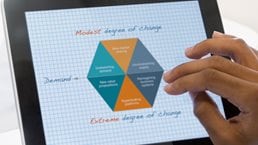The way digital technologies are reshaping the relationship between consumers and brands has been hotly debated over the past few years, with much discussion of the reshaping of consumer decision journeys, the advent of multichannel marketing and sales, and the impact of smartphones and the mobile Internet on customer behavior. Yet an even bigger opportunity has been largely overlooked. By taking advantage of big data and advanced analytics at every link in the value chain from field to fork, food companies can harness digital’s enormous potential for sustainable value creation. Digital can help them use resources in a more environmentally responsible manner, improve their sourcing decisions, and implement circular-economy solutions in the food chain.
Huge untapped potential
So far, most of the excitement about digital’s potential in the consumer-packaged-goods industry has centered on marketing and sales. But for food producers, the opportunities begin higher upstream and end lower downstream. At the upstream end, the agricultural practices followed by dairy farmers, cacao and coffee producers, wheat and barley producers, cattle farmers, and so on result in enormous variations in commodity costs in an industry where raw materials represent easily 60 percent of the cost of goods sold (COGS) (Exhibit 1).

Manufacturing and packaging also represent a substantial share of COGS, as well as contributing to companies’ environmental and social footprints and food-safety risks. At the other end of the food chain, big data and advanced analytics can be used to optimize downstream activities such as waste management. Food waste causes economic losses, harms natural resources, and exacerbates food-security issues. About a third of food produced for human consumption is lost or wasted every year in a world where 795 million people—a ninth of the population—go hungry (Exhibit 2).

Cutting postharvest losses in half would produce enough food to feed a billion more people. Global food waste and loss cost $940 billion a year, have a carbon footprint of 4.4 Gt CO2-equivalent (more than 8 percent of global greenhouse-gas emissions), and a blue-water footprint of about 250 cubic km (3.6 times the annual consumption of the US). In 2007, the amount of food wasted globally equated to 1.4 billion hectares—an area bigger than Canada—of agricultural production.
Using technology to improve areas such as climate forecasting, demand planning, and the management of end-of-life products could bring enormous social, economic, and environmental benefits. For example, the French start-up Phenix runs a web-based marketplace to connect supermarkets with end-of-life food stocks to NGOs and consumers who could use them. The platform enables the supermarkets to save the costs of disposal, gives consumable products a second life, and alleviates some of the social and environmental burden of waste.
Would you like to learn more about our Consumer Packaged Goods Practice?
The opportunities for digital innovation in the food chain are enormous and vary by context, with some well suited to emerging markets and others more appropriate to mature economies.
Efficiency opportunities for emerging economies
Emerging markets can tap the potential of digital in the food chain through innovations such as precision agriculture, supply-chain efficiencies, and agriculture-focused payment systems.
Precision agriculture is a technology-enabled approach to farming management that observes, measures, and analyzes the needs of individual fields and crops. By allowing farmers to apply tailored care and manage water more effectively, it boosts production, improves economic efficiency, and minimizes waste and environmental impact. Its development is being shaped by two technological trends: big-data and advanced-analytics capabilities on the one hand, and robotics—aerial imagery, sensors, sophisticated local weather forecasts—on the other. According to 2014 estimates, the global market for agricultural robotics is expected to grow from its current $1 billion to $14–18 billion by 2020.
New entrants and large companies alike are developing products and services for precision agriculture. The start-up CropX offers sensors to help farmers adjust irrigation to the needs of their soil, while Blue River uses computer vision and robotics to determine the needs of individual plants. At the opposite end of the scale, IBM has developed a highly precise weather-forecast technology, Deep Thunder, and an agriculture-specific cloud technology.
Recommendations can be adjusted in real time to reflect changing weather conditions. Soil sensors and aerial images help farmers manage crop growth centrally, with automated detection systems providing early warnings of deviations from expected growth rates or quality.
Automated systems showing the status, performance, and potential bottlenecks of critical equipment in real time can be used to optimize fleet management, thus increasing delivery reliability and preventing spoilage. Transport times can be cut in half by using smart meters to improve routing. Coupling transport-management systems with agricultural sensors can allow unified hauling of inbound transportation, generating average savings of 10 to 20 percent.
Agriculture-specific payment systems and financial services can help farmers make their economic models more resilient. Some growers use insurance contracts to offset weather risk, for instance. Insurers calculate a premium on the basis of the likelihood of a particular weather event, such as frost, and the impact it would have on a crop at a specific point in its growth cycle. The premium is paid out when the number of occurrences surpasses a predefined threshold.

Strategy in a digital age
Our series on developing corporate and business-unit strategies in a digitally disrupted world.
Payments is another area where digital solutions can make food chains more efficient. In Kenya, Sokopepe provides a trading platform for agricultural commodities that links small-scale producers to retailers and bulk purchasers via mobile-phone messaging. Another Kenyan initiative, MFarm, provides up-to-date market prices via an app or SMS and connects farmers with buyers, offering a group selling tool for those farmers too small to market to a large buyer by themselves.
Solutions to systemic challenges for mature economies
Developed countries can use digital tools and methods to tackle challenges such as improving the safety of food, the sustainability of sourcing decisions, and companies’ environmental footprints.
Food safety could be improved through the adoption of innovative technologies such as consumer food scanners that analyze a dish using spectroscopy and give users immediate information on its composition (Exhibit 3). The European Commission recently launched a competition to develop a viable, affordable, and noninvasive food scanner, with a prize of €800,000 in funding for the winning team.

Two groups of people would derive particular benefit from these devices: sufferers from food-related illnesses such as obesity, allergies, and intolerance, and health-conscious individuals wishing to use food scanners as a complement to activity trackers. In view of the global epidemic in obesity and type-2 diabetes, estimates suggest that the market for personal food scanners could reach US $1 billion by 2020.
Sourcing decisions could be made more sustainable by adding yield-forecasting and risk-assessment tools to agronomic modeling methods to assess the impact of hyperlocal weather forecasts on a particular plant’s yield and soil conditions. This would allow global food manufacturers to not only choose the best regions and countries to source from, but also to adapt their sourcing routes to weather challenges. These tools could also be used to determine the ideal mix of commodities in a country’s agricultural portfolio, taking into account productivity levels by region.
Given the unpredictability and volatility of raw-materials costs, global food companies could derive huge benefits from finding ways to mitigate these risks while maintaining a responsible sourcing strategy toward growers.
Environmental-footprint management is another challenge that digitization can help to address. For instance, Cisco’s Internet of Everything will provide consumers with the means to trace a food product back along its entire chain of production, from farmer’s field to supermarket shelf. A scannable code on packaging will take users to a website that provides a detailed analysis of every stage and process undergone by that product’s specific production batch.
The technology could be used to provide consumers with a guarantee of a product’s environmental credentials. One of the challenges of advanced environmental practices is the difficulty of demonstrating the reality behind marketing claims and overcoming consumer skepticism, particularly where price premiums are concerned. A robust method for tracing sourcing through to origins could support this practice and make it more economically viable for food manufacturers.
Digital methods and tools are opening up opportunities for leading food companies to improve their management not only of the “last mile” of marketing and sales, but the entire journey from field to fork.


